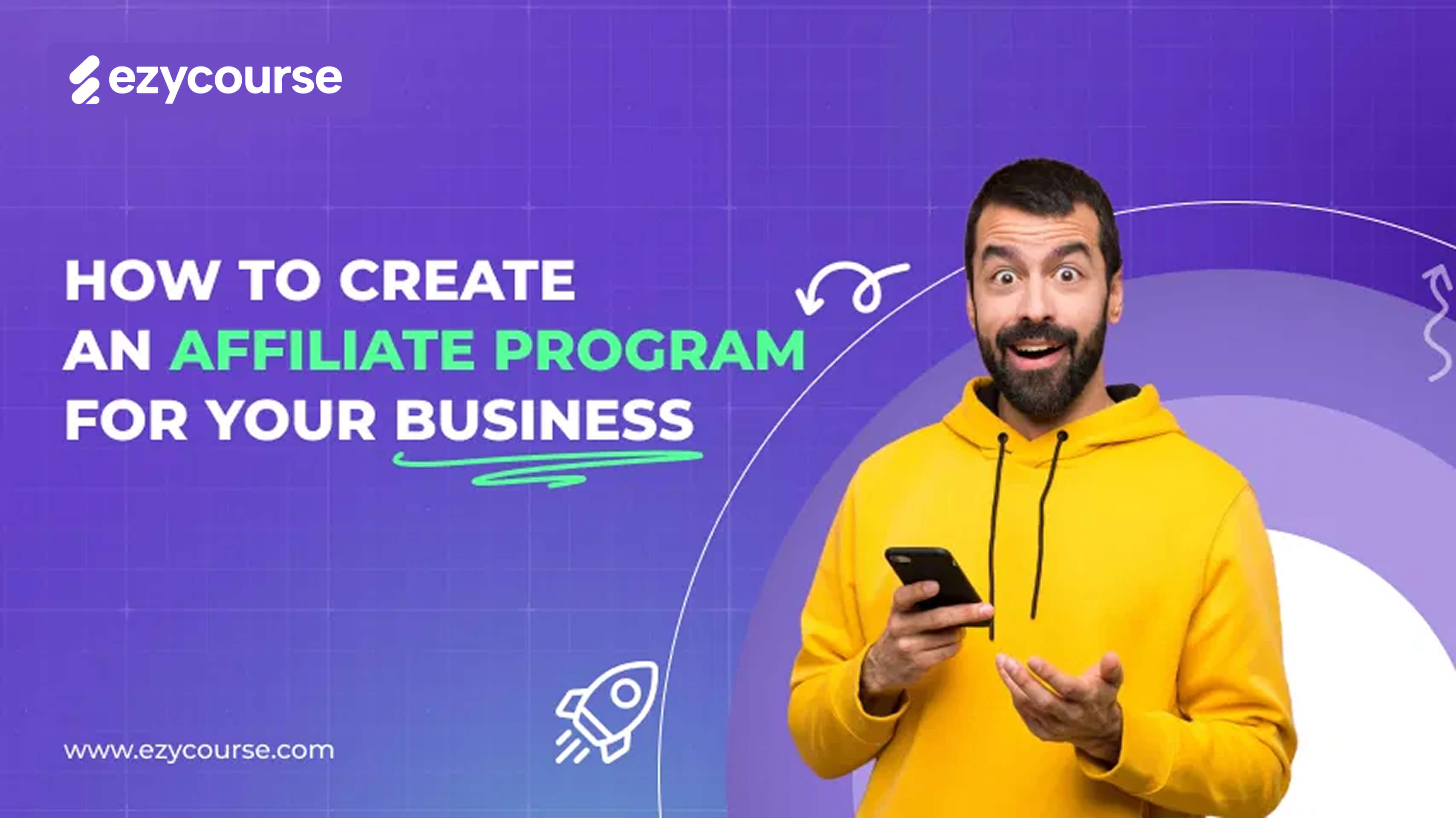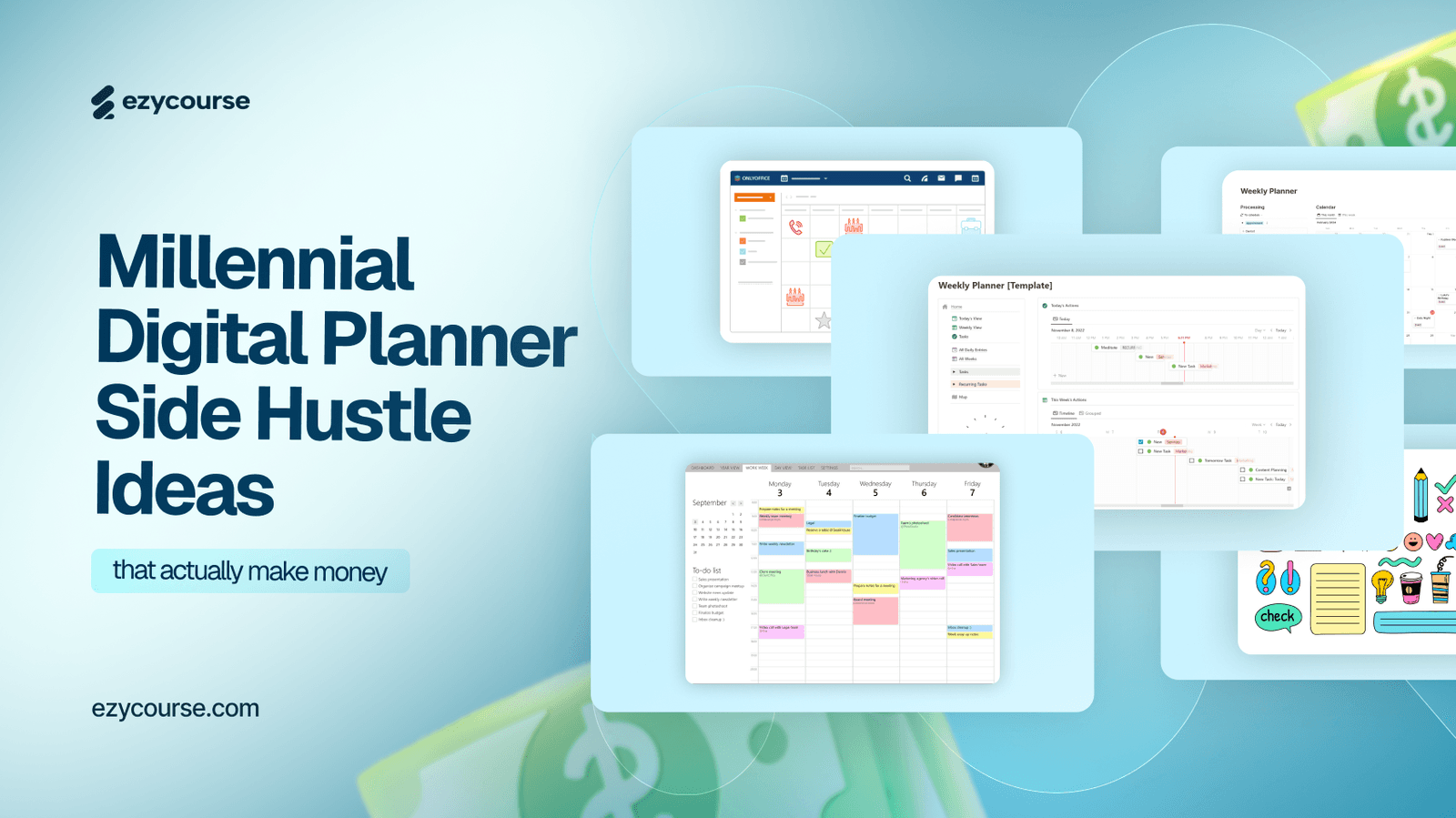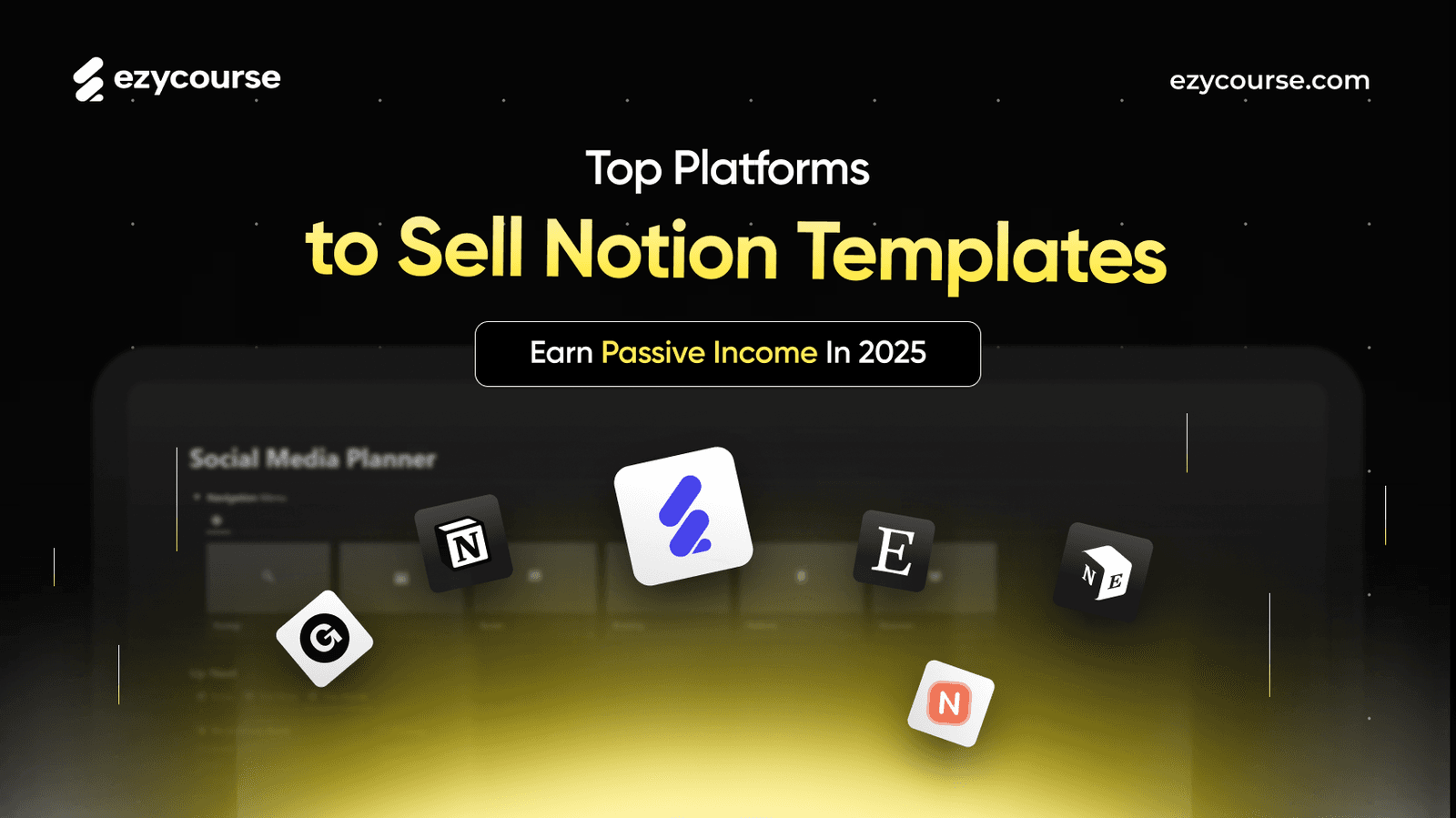Launching an affiliate program is a must if you want your business to reach the right audience and build brand credibility. But exactly how to create an affiliate program for your business? That’s what this guide will cover.
Creating an affiliate program for your business involves understanding the basics, defining clear goals, choosing the right products and platform, setting commission structures, recruiting and managing affiliates, tracking performance, and forming policies.
Brand awareness and increased sales are every business's top goals right now. Guess what’s the most legit way to achieve both at the same time? An affiliate program!
It’s a quite obvious answer because today 4 out of 5 brands use affiliate programs to target brand visibility and drive sales. Affiliate marketing spending is expected to exceed $12 billion by 2025. This marketing model is more relevant than ever, offering a low-risk strategy that has gained recognition for all the right reasons.
In this guide, we’ll also explore how to attract the right affiliates, manage them effectively, and maintain a steady flow of referrals. Let’s Get Started!
Key Takeaways:-
|
How to Create an Affiliate Program for Your Business?

Here are a few key factors you should consider before creating an affiliate program for your business:
Understand the fundamental concept of affiliate program & affiliate marketing, who should create it, and how businesses benefit from it.
Getting familiar with the 2 core sides of an affiliate program and understanding how both work together to generate profit.
Following 6 impactful strategies that can ensure running a successful affiliate program.
Finally, working on creating the program based on a structured roadmap that consists of 8 steps or elements for the maximum outcome long term.
What is an Affiliate Program? It's 2 Core Sides!
Commission-based sales are nothing new. In fact, it’s something that many conventional companies have used for making sales for so many years.
Now, take that concept online—without the need for face-to-face interactions—and you get something very close to affiliate marketing.
In a definitional view, exactly what is affiliate marketing?
Affiliate marketing is a popular frame of performance-based marketing model that uses creators, influencers, and even customers to promote a company’s products or services in exchange for a commission.
That’s from the perspective of affiliates!
Now if you’re a business looking to utilize this unique marketing approach to generate revenue through “word of mouth,” creating an affiliate program for digital marketing is a goldmine waiting to be tapped.
Digging a little deeper into how it works, the system is actually built around a shared goal that both the business and affiliate try to achieve. Could be a lead, could be a sale, or something else. The business usually decides that.
When an affiliate successfully meets this goal, they earn a commission. Or another agreed-upon benefit. Now this process relies on unique affiliate links.
And the businesses can track these links through a dedicated system. A good example is how the Shopify Affiliate Program works, manages, and monitors the links.
EzyCourse’s Affiliate System helps several businesses track sales, manage payouts, and reward affiliates effortlessly. If you run an online course, EzyCourse allows you to launch a full-fledged affiliate program where students, influencers, and content creators can promote your courses and earn commissions.

Whenever a conversion happens through one of these links, the system identifies the responsible affiliate and ensures they get paid.
Anyone who knows how to set up an Affiliate program with Amazon will also know how it’s one of the best examples in action.
Have you ever clicked on an Amazon product link recommended by a favorite YouTuber or a blogger who you find reliable? If you did make a purchase thanks to their amazing reviewing and convincing style, they received a generous commission for it.
Affiliate marketing, if done by the right affiliates, could be the best low-risk, high-ROI strategy that no top business should ignore. Not to mention, it’s also incredibly cost-effective.
All and all, affiliate marketing is a win-win arrangement for both businesses and affiliates. We’ll go more into that detail but let’s first figure out its advantages.
Why Creating An Affiliate Program Can Be a Beneficial For Any Business
Audience Reach – Businesses can tap into a dedicated audience that values recommendations. This could be from influencers, YouTubers, or other influential personalities who are great at selling on social media to boost trust in business.
By offering affiliates a strong incentive, businesses can quickly gain exposure to a trusting audience. This will eventually lead to faster and more effective brand awareness.
Strong Credibility – Today’s consumers rely heavily on online reviews, testimonials, and recommendations before making a purchase. Having a trusted individual endorse a brand not only drives conversions but also strengthens credibility.
Cost-Effectiveness – With affiliate marketing, businesses only spend when they see real, measurable results. There’s no need for costly ads or gimmicks. Just a performance-driven approach that directly leads to sales. In that sense, the overall cost remains comparatively low.
The 2 Sides of Affiliate Programs
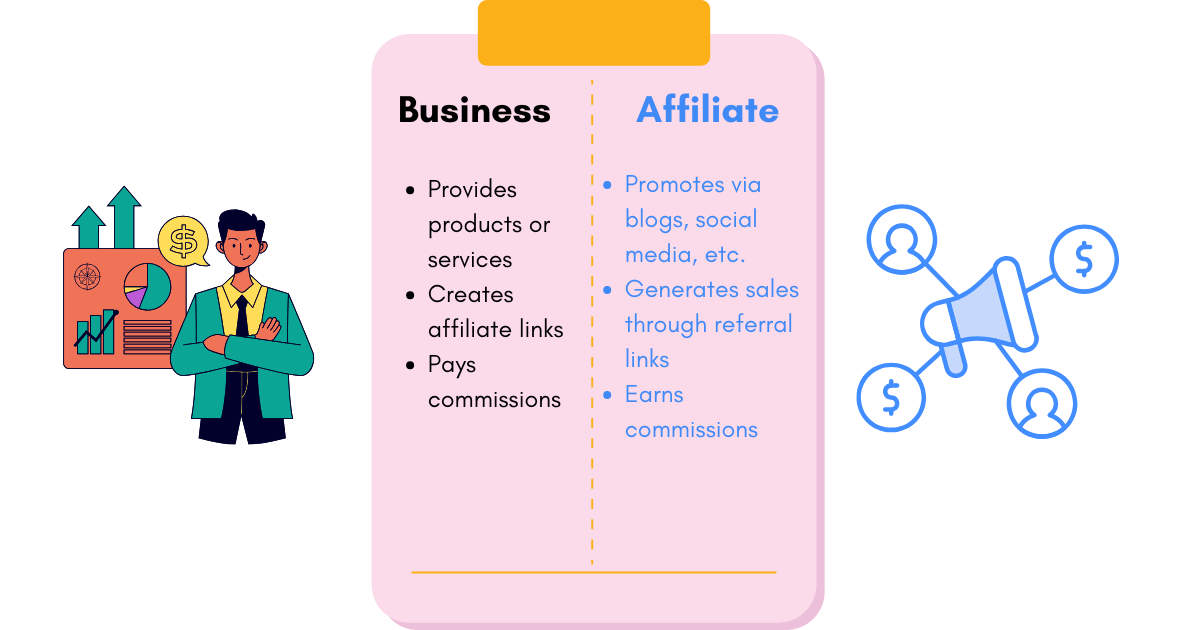
Figure 1: Two Sides of An Effective Affiliate Program
Every affiliate marketing program has two key participants: the business and the affiliate.
The Business (Product or Service Provider)
The biggest beneficiary of this system is the business that creates an affiliate program for its product or service. This side of the equation focuses on driving traffic and boosting sales.
Now this could be for someone who wants to create an online course, a live fitness coaching, an eCommerce store, or any other type of business.
A 2012 Harvard Business Review report states that affiliate marketing can be up to six times more effective than traditional marketing in attracting potential customers.
This makes sense, as affiliate marketing operates in online spaces that are already buzzing with audiences leaning towards the specific product or service being promoted.
For affiliate marketing to work effectively, the business must:
Learn how to create an affiliate link and provide each affiliate with a unique, trackable link.
Offer compelling enticements to creators, bloggers, and influencers to promote the brand.
Ensure timely commission payouts for successful conversions.
EzyCourse simplifies the entire process of creating an affiliate program for you! Instead of setting up from scratch, create and manage an affiliate program directly from your dashboard. Use the most powerful multi-level affiliate system to scale your business!
This setup maximizes visibility while keeping costs tied to actual results. Clearly, it eliminates wasted ad spend and helps to build a scalable affiliate program for your business growth.
The Affiliate (Promoter)
On the other side of the equation are the promoters, also known as affiliates. These are individuals with influence that businesses use to their advantage—in a positive way, of course.
Affiliates receive a good payback for their contributions, though the exact amount is typically pre-determined rather than fixed. The commission structure varies from business to business. Amazon’s payout rates differ from Shopify's Affiliate Program commission. And so on!
Affiliates can be:
Bloggers who write niche-related articles promoting the business.
YouTube creators who review or provide testimonials for products or services.
Social media influencers who drive sales by recommending products or services to their followers.
Digital marketers can create valuable resources that encourage potential customers to take action.
Existing clients who can share their experiences to bring in new customers.
For affiliate marketing to work effectively, the affiliates must:
Understand the product or service.
Experience it firsthand to provide a genuine review.
Assess whether it aligns with their audience's interests and needs.
Create valuable content that educates their audience about the product or service.
Promote it using the unique affiliate link provided by the business.
Encourage action through strategic marketing and SEO tactics.
Ensure proper commission tracking to receive payments without any issues.
Affiliate marketing is a strong passive income stream that isn’t fading anytime soon. According to Authority Hacker, 80% of affiliates earn between $0 and $80K annually, while around 15% make roughly a million or slightly more per year.
While these numbers may not seem mind-blowing, they offer a generous monthly income. Those fortunate enough to be in the top 1% can even achieve six- to seven-figure monthly earnings through affiliate marketing.
6 Best Practices for Creating an Affiliate Program for Your Business
Every great recipe has its secret ingredients that make it what it is. Now, we’re not talking about cooking up a four-course meal here—but even though it’s not the same thing, a successful affiliate program too has its own special recipe.
We’ve rounded up not one, but 6 essential ingredients to help your affiliate program become a hit. Enjoy!
1. More Than Just Affiliates—Think of Them as Brand Ambassadors
You're not simply choosing influencers to throw words into the air about your product or service. Your affiliates should be people who genuinely add value to your brand’s online presence.
Consider providing resources to help them transition from affiliates to brand ambassadors. Guide them on how you’d like your brand to be represented to a wider audience.
Unless your business is misleading about its offerings (which it shouldn’t be!), there’s nothing wrong with shaping the message around the value your product or service provides. It’s a pretty smart move any digital marketer would appreciate!
Just to be clear—brand ambassadors and affiliates aren’t the same, but they do share a common goal.
Affiliates promote a product, even if they haven’t used it (though firsthand experience is always better), while brand ambassadors actively use and advocate for it.
In a recent article, the popular ambassador management platform Roster breaks down the differences. It seems that affiliates are simple and affordable to manage since they earn commissions based on sales. They promote multiple brands without long-term commitments. Unlike brand ambassadors, who may need contracts or extra benefits.
2. Make Your Product Something People Want to Buy
Ever wonder why someone decides to buy a product or service? The consumer urge that makes them click a link and make that purchase, it’s related to solving problems.
Think about it—when you’re hungry, you buy food. If you need to learn English, you look for a tutor. A medical emergency? You call an ambulance.
Every action is driven by a need. And people are willing to spend when they find a solution that truly helps them.
When selling anything, your primary focus should be on making it irresistibly valuable by solving a real problem. If your product doesn’t feel essential, no marketing strategy—affiliate or otherwise—can make it successful.
For example, if you’re selling a course, make sure it:
Addresses real concerns—expect and answer the questions the learners will have.
Goes beyond the basics—don’t just put together surface-level information but provide in-depth insights.
Delivers real value—help students achieve the goal that led them to your course in the first place.
Is well-organized—a structured, easy-to-follow course keeps learners engaged.
When your product naturally solves a problem, it becomes easier to promote. Affiliates can confidently recommend it, and their audience will see the genuine value—leading to stronger sales and a more successful affiliate program.
3. Decisions Are Based on Metrics, Not Instinct
Successful businesses rely on key metrics to guide their next steps—not just gut feelings. By analyzing hard data, you can fine-tune your affiliate program, spot trends, optimize campaigns, and adjust commission structures for the best ROI. Modern platforms simplify the process by tracking conversions in real time, giving you a clear picture of which strategies are driving the strongest results
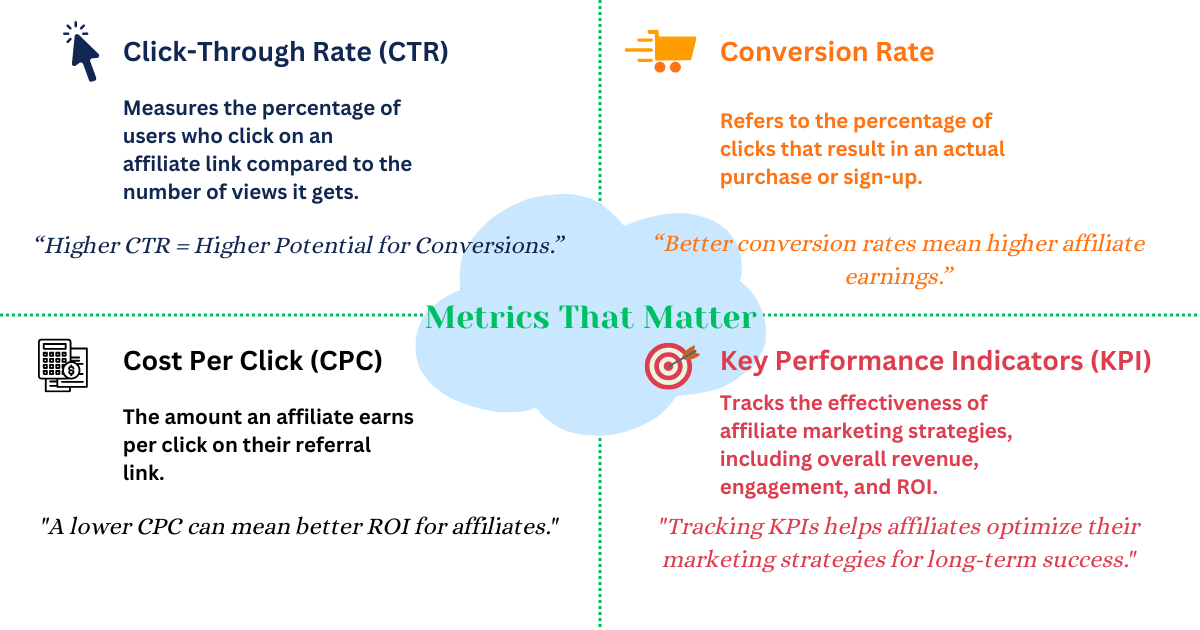
Figure 2: Key Metrics of Affiliate Program
Here are some essential metrics to track:
CTR (Click-Through Rate): The percentage of users who click on your affiliate links.
Conversion Rate: The percentage of visitors who purchase after clicking through an affiliate link.
CPC (Cost Per Click): The total cost incurred for each click in your affiliate campaign.
KPI (Key Performance Indicators): Measurable goals that help track success and guide necessary adjustments to improve results.
EzyCourse's easy-to-use affiliate dashboard helps to track critical metrics like click-through rates, conversions, and affiliate earnings all in one place. Analyze these data points and optimize your campaigns for the best results.
4. Keep Your Affiliates Connected
It’s a great idea to create an affiliate network for your business. Help your affiliates connect by creating a community or even a group chat.
Building a network of affiliates not only brings some motivation into the room but also significantly increases overall engagement.
Encourage them to share how many new customers they’ve brought in. You should also consider rewarding the top performers.
Keep the space active with content, forums, and valuable resources to help affiliates work smarter and earn more—while you hit your key performance goals.
It’s Not Just About Instant Growth
Anything that only lasts for a short time will create temporary momentum but won’t have real value for long-term growth.
Any affiliate campaign that focuses only on quick wins will struggle to build credibility and a loyal following.
That’s why it’s important to include strategies with measurable, lasting impact. Whether it’s offering advanced training, tracking performance effectively, or continuously refining your approach.
6. Keep Your Focus on Profitability
It’s important to offer competitive commissions to your affiliates—but never at the expense of your bottom line.
Maintain a balance by keeping margins in check and running an affiliate program for your business with strategic promotions where needed.
This way the commission rates, affiliate benefits, pricing, and other program elements will not only support growth but also never undermine profitability.
To set up a profitable affiliate program for your business, keep in mind it doesn’t need a huge budget; instead, it should be built on strong fundamentals with room to scale and drive high performance.
EzyCourse’s Stripe Connect integration for auto payouts ensures affiliates are paid on time! This means time saved for focusing on scaling the business. The platform offers built-in tools for flexible commission settings, ensuring the affiliate program is both profitable and sustainable in the long run.
How to Create an Affiliate Program for Your Business? [8 Steps]
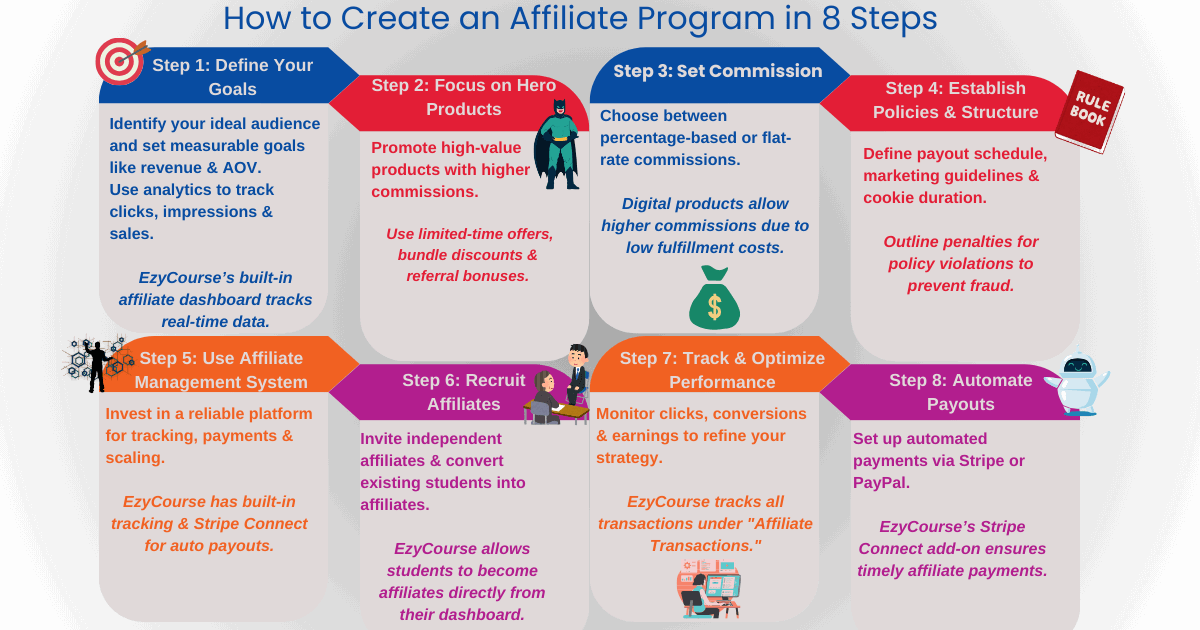
Figure 3: The 8 Steps To Create An Affiliate Program
Let’s jump into the main parts of starting an affiliate program for a business.
Step 1: Make a List of Practical Goals to Achieve
For any business, the primary goal of creating an affiliate program is to attract the right customers. And that’s why, before setting up the program, consider these key questions about the target audience:
What specific audience category do you want your affiliate program to attract?
Who are the ideal affiliates for reaching this audience effectively?
These two questions are essential for the overall Affiliate program set up for your business goals. Once you have the answers, focus on setting measurable goals.
The most important one has to be expected revenue from the affiliate program. It could be taken into account annually, quarterly, or monthly.
You should also consider the AOV (Average Order Value) per affiliate along with the total unique sales per affiliate within a given time frame.
Tracking key performance metrics like affiliate-driven sales, clicks, impressions, and leads consistently can also help refine your strategy.
This means a better scope of identifying necessary adjustments to maximize results. A solid analytics system can simplify this process, making it more efficient and data-driven.
EzyCourse makes tracking key performance metrics effortless with a built-in affiliate dashboard. It provides real-time insights into clicks, signups, and earnings and lets you refine your strategy without the need for any third-party tools.
Step 2: Focus On Your Hero Products or Service To Promote
Whether your business is brand new or well-established, there’s likely a product or service that consistently grabs attention or delivers the best results. These are your hero products—the ones that are built to stand out and provide true value to customers.
You can utilize this fact to your advantage by running an affiliate program that encourages affiliates to focus on promoting these standout items. After all, performance marketing is all about results!
To develop an affiliate program for your business, consider including your top-performing products or services in the affiliate program.
But also keep in mind that the items you choose should have a higher average order value. Otherwise, what’s the incentive for affiliates? A 20% commission on a $100 service is much more appealing than the same commission on a $20 product.
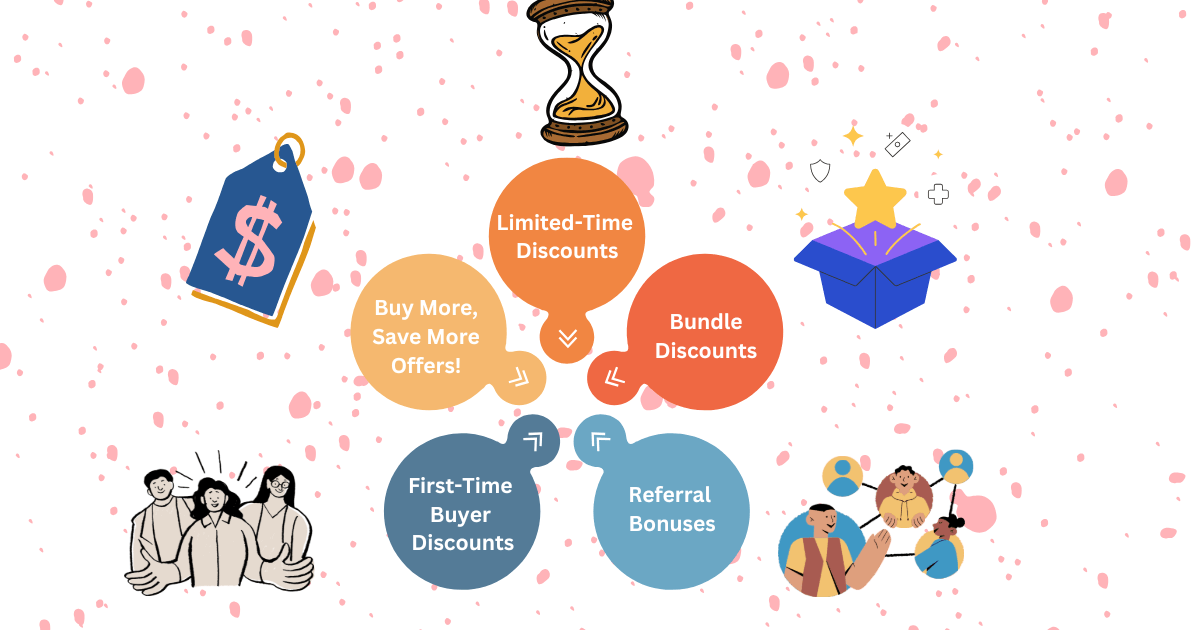
Figure 4: Different Types of Promotional Deals
To encourage affiliates and their audience, consider adding some enticing promotions, such as:
Buy More, Save More Offers: Scale discounts based on the quantity purchased. For example, offer 20% off one course, but 30% off if they enroll in two.
Limited-Time Discounts: Create a sense of urgency with a 50% off deal that lasts for just 24 hours (or less!). This can drive immediate action.
Bundle Discounts: Offer a price break when customers buy multiple products or services together, which also helps increase average order value.
Referral Bonuses: Reward your existing customers for bringing in new ones by offering a bonus or discount for every successful referral.
First-Time Buyer Discounts: Give newcomers an extra reason to purchase with a special first-time buyer discount.
Such personalized promotions not only drive great traffic but also have a strong potential to build a high-converting affiliate program for your business.
Step 3: Pay Attention to Pricing & Commission Structure

Now that you’ve identified the key products or services to highlight in your affiliate program, the next step is setting up a commission structure—or even a broader pricing strategy. Something that aligns with your business model.
Your goal is to create a reward system that’s attractive to affiliates, including those with experience, so they’ll be motivated to actively promote your offerings.
When determining commission rates, it’s extremely important to be realistic. You can’t ignore operating costs or overlook the expenses involved in acquiring new customers while still ensuring a profit. A well-balanced commission plan should take both factors into account.
Typically, businesses structure commissions in one of two ways:
Percentage-Based Commissions: A set percentage of each sale goes to the affiliate. This is the most common approach, with commission rates generally ranging from 5% to 30% (according to ReferralRock).
Flat-Rate Commissions: A fixed amount per sale, regardless of the product price.
Selling digital products often comes with higher commission rates than physical ones since they don’t have fulfillment costs.
Depending on your business model, you might also consider a hybrid approach. This means combining percentage-based and flat-rate commissions for maximum flexibility.
Whatever structure you choose, keep it adaptable. You may need to adjust rates over time to stay competitive and keep affiliates engaged.
EzyCourse makes things extra easy by allowing you to set percentage-based or fixed commissions. That too with full control over rates for different products. Such flexibility ensures you attract the right affiliates for your business model.
Step 4: Set Policy & Structure for The Affiliate Program
When building the policy and structure for your affiliate program, there are several key aspects you need to consider.
Start by creating a clear and comprehensive program guide. Make it helpful enough for affiliates to easily understand your products or services, as well as the performance expectations.
It's essential to define what qualifies as a commissionable transaction. So that payouts are based on reasonable benchmarks and occur within a set timeframe.
Another important step is identifying the channels that affiliates will use to promote your business. Some may prefer email marketing to reach their targeted audience, while others might rely on social media to engage their followers.
Certain affiliates may even opt for webinars or other interactive formats to drive sales. Understanding these preferences can help you provide better resources and guidance.
Once you establish how to create affiliate links for your business, you’ll also need a strategy for how affiliates can share these links effectively.
This includes determining the role of affiliate cookies, which track referral activity and dictate how long commissions remain valid after a visitor clicks the link. Setting an appropriate cookie duration ensures fairness and maximizes the potential for conversions.
To streamline the process, consider using performance marketing templates that outline all necessary terms and conditions for your affiliate program.
However, if you prefer to draft your own affiliate policy and rules, be sure to cover the following:
Payment Schedule: When and how affiliates will receive their earnings.
Payout Methods: Whether payments will be made via PayPal, Stripe, or another platform.
Marketing Guidelines: Which promotional methods are allowed and which are restricted?
Keyword Usage: Any limitations on specific keywords in paid ads.
Excluded Products/Services: Items that are not part of the affiliate program.
Compliance & Penalties: Actions that may result in deductions or bans due to violations.
By addressing these elements upfront, you’ll create a well-structured affiliate program that operates smoothly while setting clear expectations for all participants.
Step 5: Use an Affiliate Program Management System
There are plenty of resources online that claim to help you create your own affiliate program for free. But how reliable are they?
That’s something you’ll need to think for yourself. One thing is certain, though—any business serious about marketing needs the advantages of a well-structured affiliate program.
That’s why you need to build an affiliate program for your business by investing in a paid platform designed to expand it for long-term success.
A well-rounded system to manage an affiliate program for your business should:
Make it easy to scale your program as your business grows.
Offer communication tools for managing affiliate relationships.
Provide reliable payment methods to streamline payouts.
Include setup assistance to help you launch your program effortlessly.
Offer advanced analytics and reporting for tracking performance.
Support ad campaign management and optimization.
Ensure fair and attractive commission structures.
Also, an effective platform should have a user-friendly interface, essential plugins and tools, a strong fraud detection system, and a responsive support team to resolve issues quickly.
One great example is Shopify, which integrates smoothly with online stores. There’s a dedicated app for managing the Shopify affiliate program. Using the app it’s easy to track, manage, and optimize affiliate partnerships.
EzyCourse makes it easy for online course businesses to create and scale their affiliate programs with built-in features. It simplifies the entire process—from recruiting affiliates to tracking referral sales and managing commissions—all in one place.
Each affiliate is assigned a unique referral link. Whenever a sale is made through that link, the system automatically detects and records it.
EzyCourse also supports a multi-level affiliate structure, allowing affiliates to recruit others into the program. This feature encourages organic growth by expanding your network of promoters.
Additionally, the platform integrates with Stripe Connect for automated affiliate payouts, eliminating the need for manual payments. This ensures affiliates always receive their commissions on time. As a result, there’s improved retention and motivation.
How to Set Up an Affiliate Program for Your Business on EzyCourse?
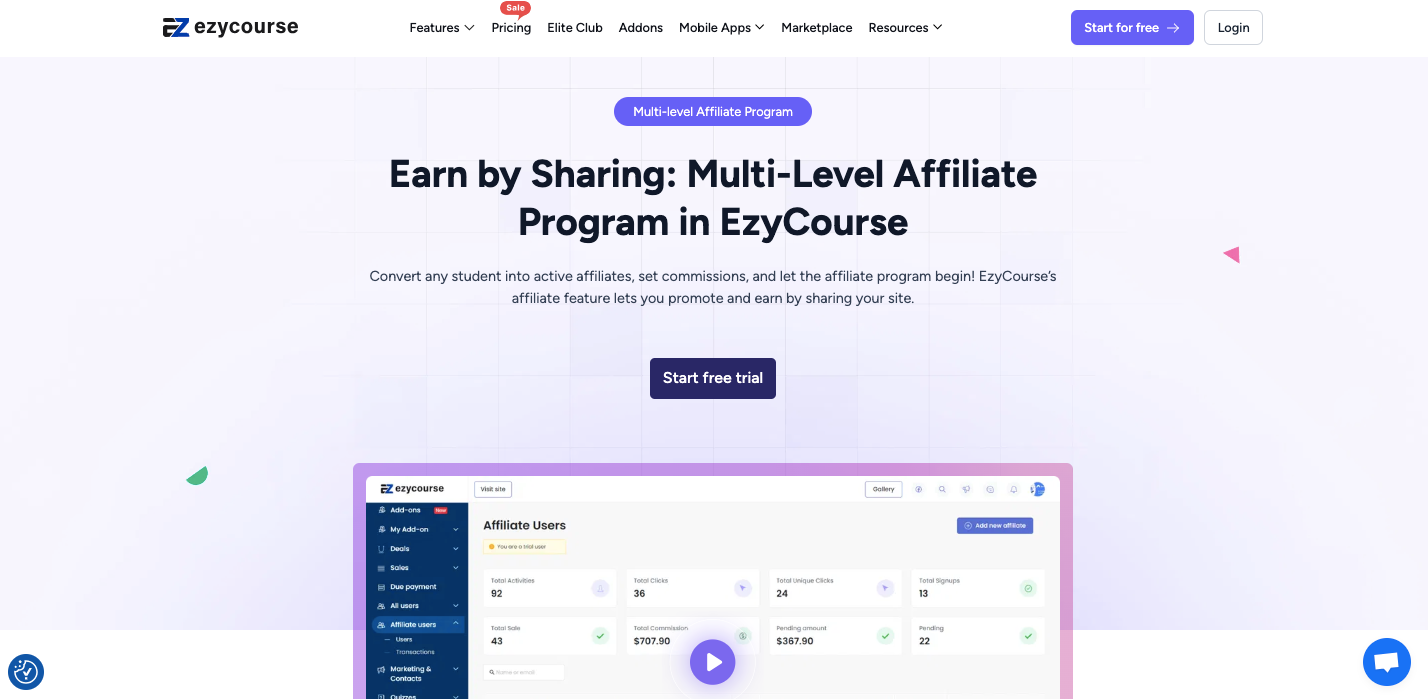
The Pro Plan includes a built-in affiliate program, while the Unlimited Plan supports a Multi-Level Affiliate Program. The latter allows affiliates to recruit others. Additionally, EzyCourse offers a Stripe Connect Auto Payout add-on. It automates commission payments for easy distribution.
Step 1: Adding Affiliates
EzyCourse supports two types of affiliates:
Independent Affiliates – These are individuals who are not enrolled in any course but want to promote your content.
Student Affiliates – Existing students who can be converted into affiliates to promote the courses they take.
To add an independent affiliate who is not enrolled in any course:
Navigate to Deals & Sales → Affiliate Users.
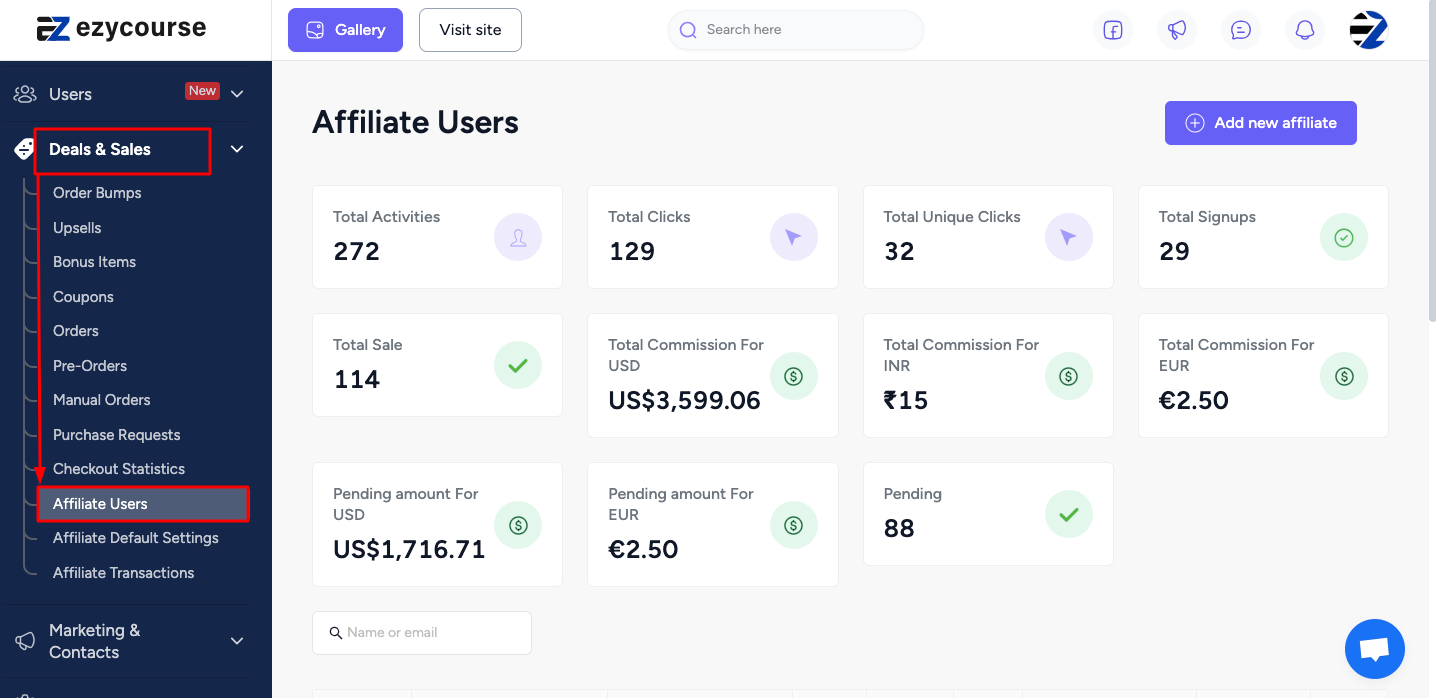
Click Add New Affiliate.
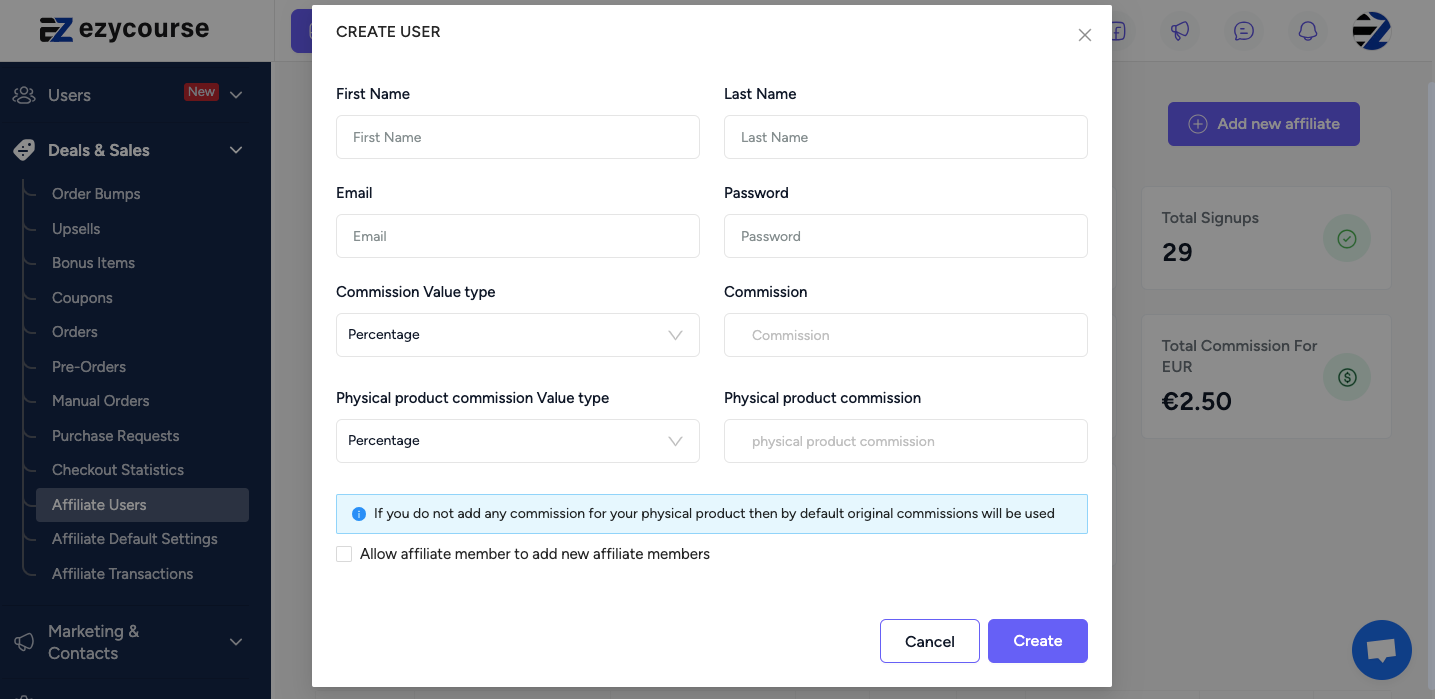
Enter their Name, Email, and Password.
Choose the Commission Type (percentage-based or fixed amount).
Once added, EzyCourse will generate a unique referral link for them to share.
Step 2: Converting Students into Affiliates
Your existing students can also become promoters by being converted into affiliates. Here’s how:
Go to Users → Students in your dashboard.
This will display a list of all enrolled students.
In the Action column, click the three-dot menu.
Select Add Student as an Affiliate.
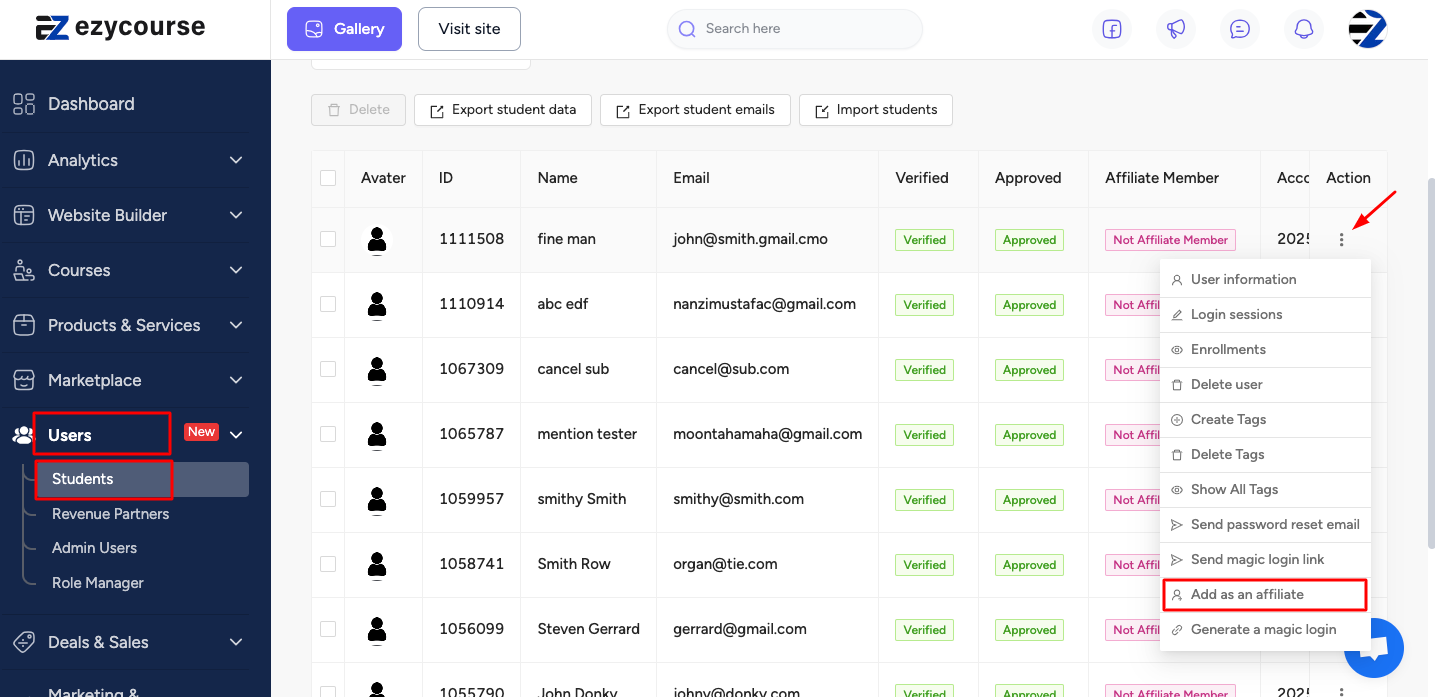
Set their Commission Type (percentage or fixed amount).
Step 3: Tracking and Managing Affiliates
EzyCourse provides a comprehensive Affiliate Dashboard, allowing affiliates to track their clicks, signups, and earnings.
For course owners, managing affiliate transactions is easy. Simply navigate to Deals & Sales → Affiliate Transactions.
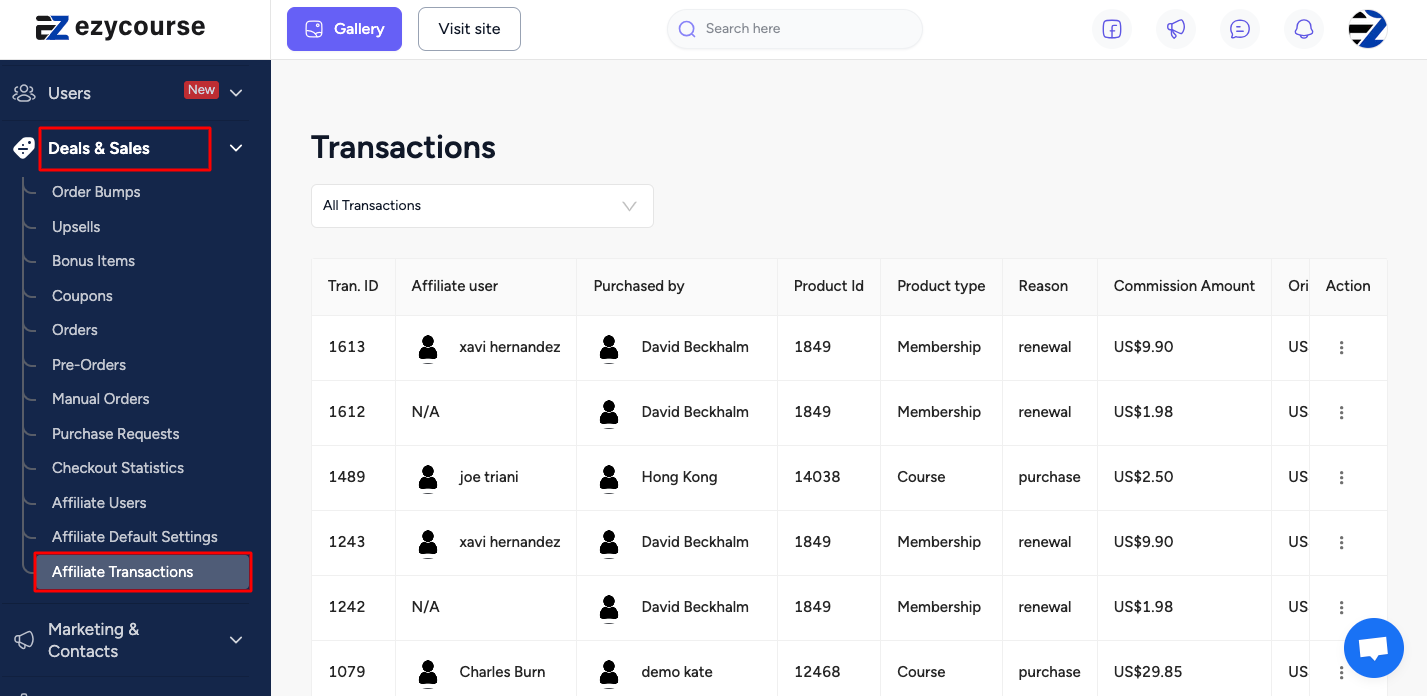
Here, you can track sales, commissions, and pending payments. This system ensures full transparency in commission payouts for both parties.
Step 4: Automating Payouts
EzyCourse simplifies affiliate payments by supporting Stripe Connect and PayPal for automated payouts and it does that on your predefined rules. This ensures that affiliates receive their earnings on time without requiring manual intervention.
To enable Stripe Connect Auto Payouts, affiliates must first connect their accounts:
The affiliate user must connect to Stripe Connect via their dashboard.
As the course owner, you’ll need to approve and process payouts:
Go to Deals & Sales → Affiliate Users.
Locate the affiliate’s details.
In the Transactions section, select Pay with Stripe to complete the payout.

Step 6: Put Effort Into Attracting the Right Affiliates (Most Important!)
Recruiting the right affiliates is a key part of running a successful affiliate program. And that is why many top businesses actively seek out and invite promoters. Particularly those who have an audience that aligns with their niche.
Rather than simply taking a passive route, they put in the effort to find affiliates who can genuinely add value to their brand.
In fact, some affiliate programs have strict criteria that applicants must meet to be accepted. Take Twitch, for example—the platform requires affiliates to meet specific follower or engagement thresholds before they can join. This approach helps ensure that affiliates bring real influence and reach.
Getting the Word Out About Your Affiliate Program
To catch the attention of the right affiliates, you need to actively promote your program. Here are some effective strategies to let potential affiliates know about your business:
Utilize your existing marketing channels to announce your affiliate program’s launch. If you already have a solid social media presence, chances are some potential affiliates are within your audience. A simple announcement post could encourage them to reach out.
You may have the resources to research top promoters in your niche. Try creating a targeted list and use email marketing to connect with them. Personalized email invitations tend to be more impactful in driving affiliate engagement compared to generic outreach.
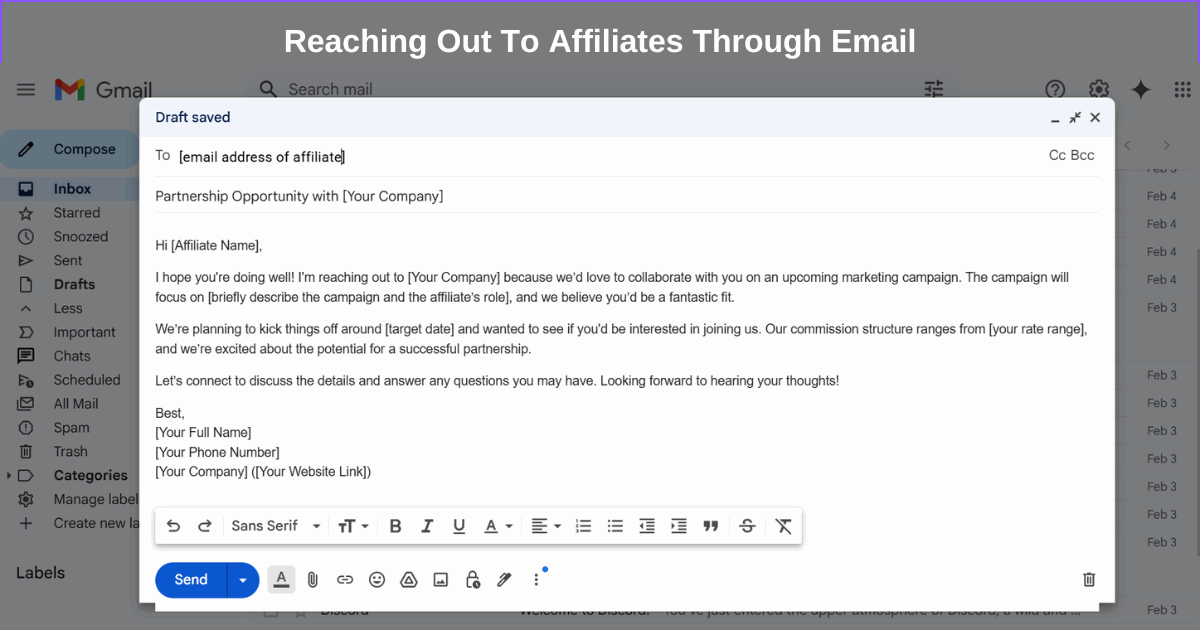
Figure 5: Personalized Email Samples For Inviting Affiliates
Do you have an existing email list? Then don’t overlook its potential. Sending a well-planned email can be highly effective in attracting affiliates. Don’t forget to mention the benefits of your program and encourage them to apply. Or even share the opportunity with others who might be interested.
Don’t forget to work on the announcement page of your business website for your affiliate program. If you are a popular one in the industry, quite likely interested affiliates already visit your site.
Learn to design an affiliate program for your business by having a well-optimized page dedicated to explaining it.
Optimizing Your Website for Affiliate Sign-Ups
To optimize an affiliate program for your business to allow affiliates to join in the easiest way possible, these are some of the best practices you should try out:
Make the sign-up link easily accessible – Consider placing it prominently in the website footer. You can also have it as a sticky button that’s always visible.
EzyCourse’s Affiliate Sign-Up Widget lets create a dedicated sign-up page for affiliates. New affiliates can register themselves and you can approve them. This means you don’t have to reach out to every potential affiliate individually. Only need to share your sign-up link, and they can join instantly.
Highlight the benefits – Your landing page should communicate the benefits of joining your affiliate program. In fact, if needed, you should invest in a designer or learn how to create a landing page for affiliate marketing.
Include a simple sign-up form – Make the process as smooth as possible by providing a user-friendly form that allows affiliates to join with minimal hassle.
Build credibility – Affiliates want to promote reputable businesses. Ensure your website looks professional, includes high-quality content, and provides enough information about your products or services. Your website should look legit to them!
Why Promoting Your Program to Affiliates Matters
While affiliates are responsible for promoting your product to their audience, you first need to market your program to them. They need to understand the value of partnering with you before they can effectively share your offerings with others.
Think about it—why would a high-quality affiliate risk their hard-earned reputation on a product or service they’re unsure about? Naturally, they’ll have questions, and you need to be ready to answer them.
Having an affiliate program guide is a great start, but some experienced affiliates may want to go a step further by speaking directly with your team.
Ensure your team is well-prepared to provide answers, clarify any concerns, and offer additional insights. Winning over a top-tier affiliate can be incredibly valuable, as their endorsement can expose your business to a much larger audience.
Top Qualities Of Ideal Affiliate
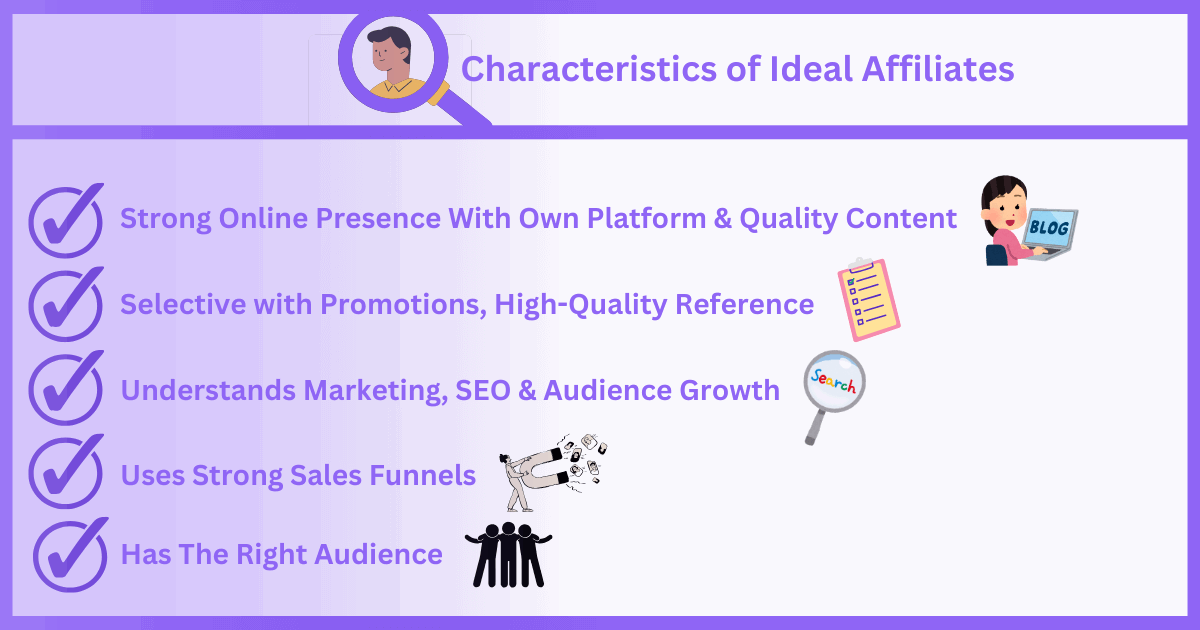
Figure 6: Qualities of an Ideal Affiliate
There are plenty of affiliate networks that can help you connect with a large number of affiliates quickly. However, even as a small business, having the flexibility to handpick your affiliates can offer several advantages.
Here are some key traits to look for when hunting the right affiliates:
A solid platform with lots of high-quality content that is consistently updated. This shows they take their brand seriously and are committed to delivering value to their audience.
A selective approach to picking programs. Affiliates who are picky about the products or services they endorse tend to have more credibility. When they share your program, their audience is more likely to trust and engage with it.
A strong understanding of marketing, particularly SEO. The right affiliate knows how to get your program in front of the right audience by ranking well on search engines.
Experience in building effective sales funnels for affiliate marketing. The best affiliates often have their own optimized funnels designed to drive conversions.
Once you identify potential affiliates, reach out with an offer that sits well with their interests and adds real value to their audience.
Your students can be your best marketers! EzyCourse allows you to convert students into affiliates with a single click. Your students can share referral links and earn commissions when their friends sign up with EzyCourse.
Step 7: Monitoring Affiliate Performance & Making Improvements
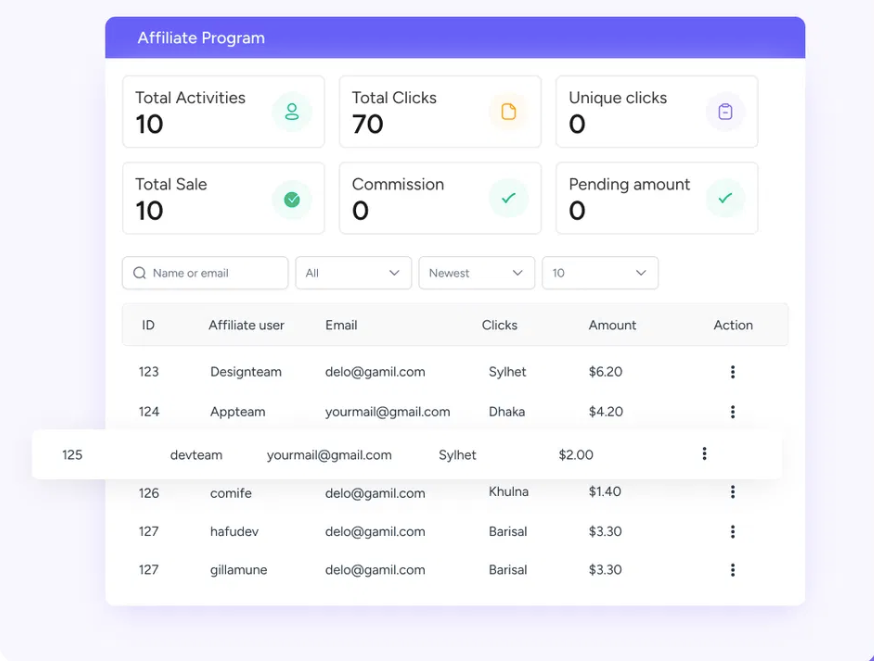
Once you've entrusted affiliates with promoting your product or service, you can’t just sit back and expect results to roll in. It’s quite important to track their performance and have a system in place that allows you to monitor their impact.
With this data, you can actually make informed decisions to further enhance your affiliate program’s success.
For instance, identifying your top-performing affiliates helps you recognize those bringing in the most value. Keeping them motivated and engaged is key to maximizing their potential. But how do you do that?
You need to strengthen your relationships with your best affiliates. Consider offering them exclusive rewards, early access to new features, or higher commission rates as an incentive. A little recognition and appreciation go a long way in keeping them happily committed.
Key Metrics to Assess Affiliate Performance
Several essential metrics can help you evaluate how well your affiliates are performing:
Total Affiliate Sales – Measures the total revenue generated from affiliate-linked sales. (A key indicator of overall program performance.)
Sales per Affiliate – Tracks the number of sales each affiliate contributes to. (Helps identify top performers.)
Average Order Size – Calculates the average purchase value through affiliate links. (Indicates how affiliates impact sales compared to non-affiliate methods.)
Total Payout – The total amount paid to affiliates over a given period. (Crucial for budgeting and forecasting.)
Payout-to-Sales Ratio – Determines what percentage of affiliate-driven sales is allocated to commissions. (Ensures your commission structure remains profitable.)
Gross Margin – The profit left after covering affiliate payouts and other direct costs. (Helps assess whether the program is generating sustainable revenue.)
Total Number of Affiliates – The number of active affiliates in your program. (Reflects program popularity and growth potential.)
Number of New Affiliates – Tracks recently joined affiliates. (A useful metric for measuring growth.)
Number of Affiliates Who Have Left – The total count of affiliates who have exited the program. (A key indicator of retention and program appeal.)
Now you need something to bring back their interest. Could be a special reward or even a discount. But only give access to the special reward or discount when they take an action. For example, extra commission along with the regular commission to bring their first customer.
You can choose from several actions; this should be according to what benefits your program the best. Writing a blog post, sharing on social media, or even running ads can be great starting points.
Also! Have Something For Motivating The Inactive Affiliates
You might come across affiliates who are kind of struggling and aren’t actively promoting your product or service. Maybe "struggling" isn’t the right word, but rather just not fully engaged.
In such cases, you’ll need something to reignite their interest. A special reward or exclusive discount could do the trick. But here’s the thing - tie these incentives to specific actions.
Other possible engagement methods include:
Offering exclusive discounts they can share with their audience.
Encouraging them to write a blog post about your product.
Providing bonuses for running social media promotions or ads.
The right reward paired with the right action, can make all the difference.
Extra Tips - Offer the Right Tools to Your Affiliates
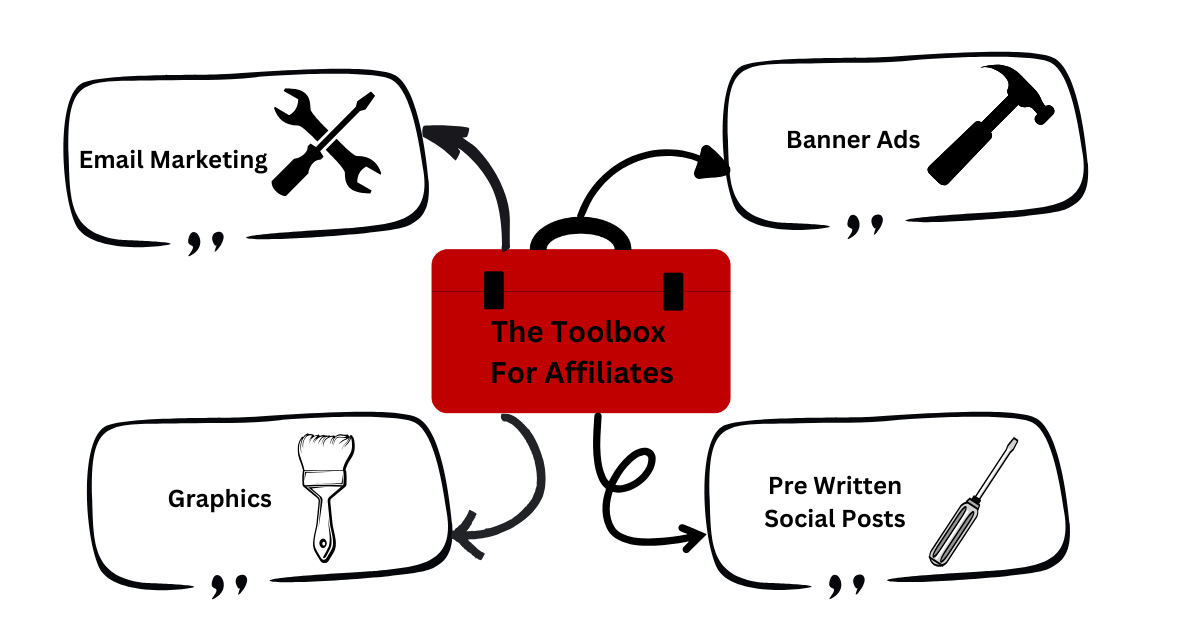
Figure 7: Offer Promotional Resources To Affiliates
Any affiliate would love the idea of having a well-equipped toolkit that makes it easier to promote a product or service. By providing the right resources, you not only empower your affiliates but also increase the likelihood of successful promotions.
Be the business that simplifies their efforts, and you’ll quickly notice the difference.
A Variety of Marketing Collateral - Ready-to-use marketing materials can do wonders to boost your affiliates’ productivity. This can include email templates, banners, pre-written social media posts, other types of posters, even relevant hashtags, and whatnot. It’s all about making it easier for affiliates to market your brand for better results.
Relevance & Staying Up-to-Date - Make sure that all marketing materials align with your brand’s image, tone, and messaging across different platforms. Also, staying up-to-date with today’s promotional trends is important.
Outdated banner ads with generic stock images won’t engage audiences as effectively as high-performing social media content—think Instagram carousels, TikTok snippets, short-form videos, and eye-catching infographics. Keeping your marketing assets fresh and relevant will make a huge impact.
Knowledge Base Library - Affiliates should have a solid understanding of your business, including key selling points, brand values, and essential guidelines.
A well-organized knowledge base that features webinars, graphics, video tutorials, and other resources can be a game-changer. The more informed your affiliates are, the more confidently they can promote your brand.
Step 8: Setting Up Automatic Payouts For Timely Payment
Let’s say you’ve set up everything correctly till now! Your affiliates are working hard, driving traffic and sales, and basically doing their best.
Now the last thing they want is to wonder if their earnings will ever show up. No one likes chasing payments or dealing with complicated manual processes.
And that’s why, we advocate including automatic payouts as a must-have to run a successful affiliate program. By opting for an automated system, you’re not only ensuring they get paid on time, but you’re also showing that you genuinely care about their contribution.
The trick is to choose a platform that flawlessly integrates multiple payment methods while keeping an eye on every transaction. This not only reduces the risk of errors but also guarantees that your affiliates always receive what they deserve.
Not to mention, when your affiliates see that you’ve got everything under control, they’re more likely to stick around and even bring more partners on board.
Wrapping Up
Marketing doesn’t have to be expensive—when done right. That’s exactly why affiliate programs have taken off. Instead of spending upfront on ads, you share a portion of your earnings with someone who helps drive sales.
You need an affiliate program if your business sells digital products, courses, or memberships. These do really well with word-of-mouth marketing and work as a low-risk strategy for tutors, creators, and similar businesses.
For example, someone who runs a course to teach physics online. However, if your business is about one-time high ticket sales, where there’s not much chance of repeat customers, then an affiliate program is not your thing.
Now that you understand how to create an affiliate program for your business, the next step is to actually start it. Sure, there will be challenges along the way, and you might have some questions—but with this guide, you have somewhere to start from.
If you're an online course tutor, EzyCourse makes launching your 1st affiliate program easier than ever. With easy tracking, multi-level commissions, and reliable payment automation, you can have your program up and running in just a few clicks. Get started with EzyCourse today!

